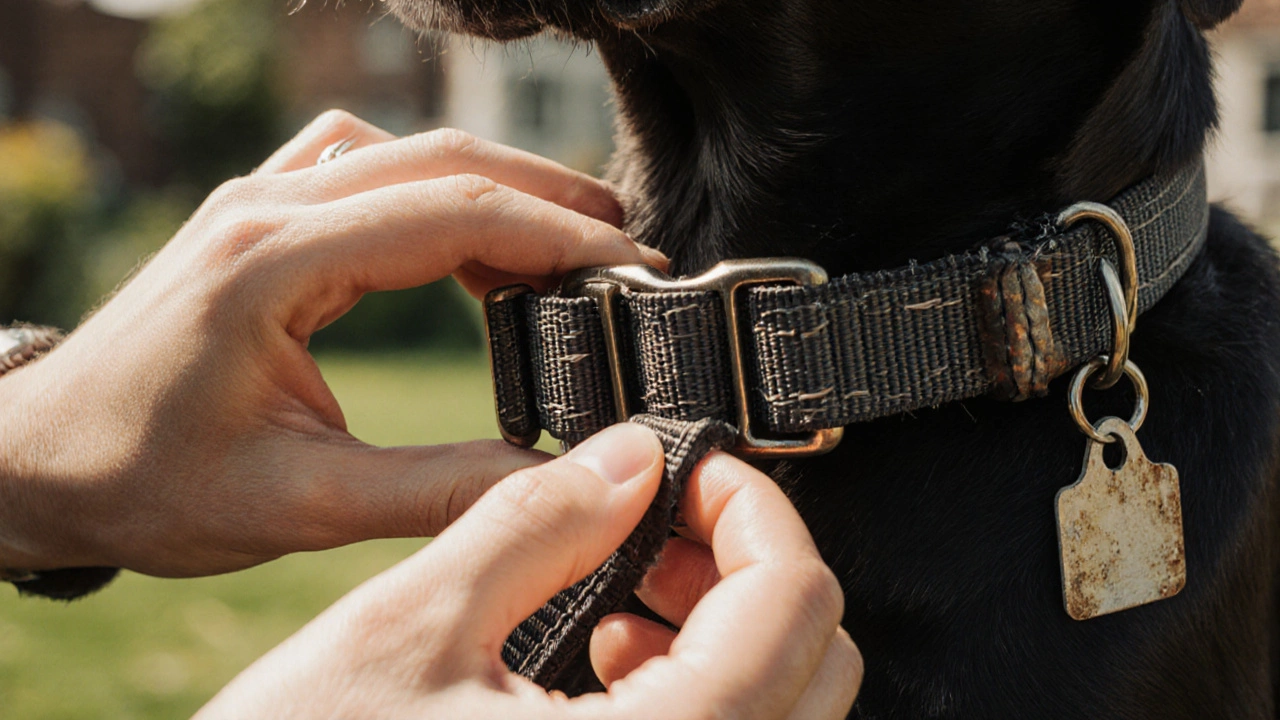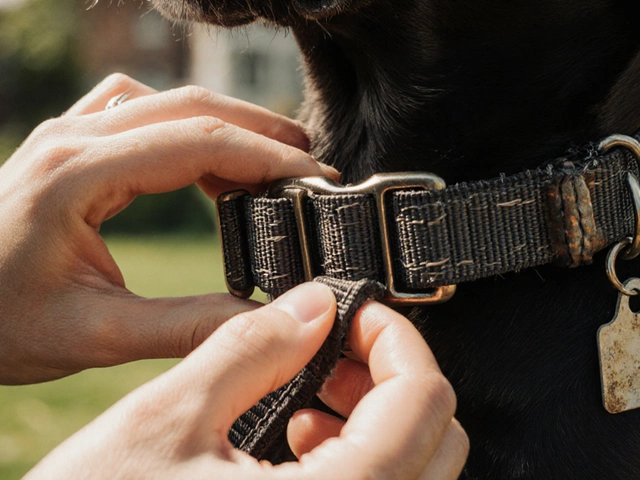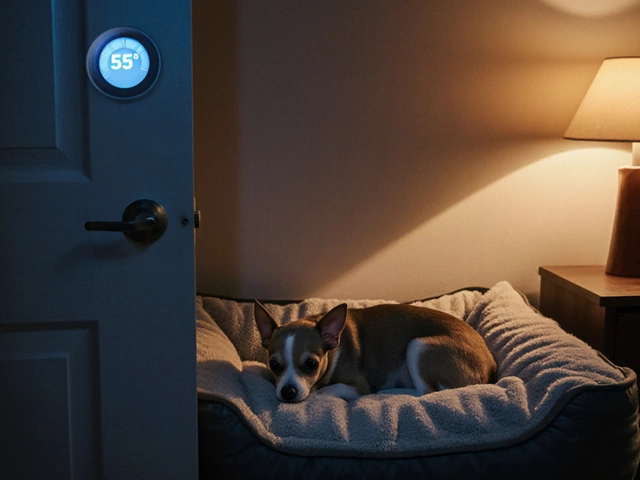Dog Collar Assessment Tool
Collar Condition Assessment
Check for Wear Signs
Your Assessment Results
Most dog owners don’t think twice about their dog’s collar-until it breaks, frays, or gets too tight. But a worn-out collar isn’t just an inconvenience. It’s a safety risk. Your dog’s collar is their lifeline during walks, ID tags, and emergency handling. So how often should you replace it? The answer isn’t a fixed number-it depends on how your dog lives, what the collar’s made of, and how well you check it.
Check Your Dog’s Collar Every Month
You don’t need to replace your dog’s collar every few months, but you should inspect it every four weeks. Run your fingers along the entire length. Feel for thinning fabric, loose stitching, cracked plastic, or rust on metal parts. A collar that looks fine from a distance might be crumbling under your touch. I’ve seen leather collars that looked polished but split open when pulled, and nylon ones with frayed edges that snapped during a sudden chase after a squirrel.Also, check the buckle. If it clicks loosely, doesn’t snap shut firmly, or feels stiff when you try to open it, it’s time to swap it out. A faulty buckle is one of the most common reasons dogs slip out of their collars during walks. And don’t forget the D-ring. If it’s bent or wobbly, your leash might not hold under pressure.
Signs It’s Time to Replace the Collar
Here’s what to look for-no guesswork needed:- Frayed edges-especially on nylon or woven collars. If you can see individual threads pulling loose, it’s only a matter of time before it breaks.
- Stiff or cracked leather-leather dries out over time, especially if it’s been exposed to rain, mud, or salt. If it doesn’t bend easily or smells musty, it’s lost its strength.
- Loose or missing hardware-rings, buckles, or tags that rattle or don’t sit flush. These aren’t just ugly-they’re dangerous.
- Stains that won’t come out-if your dog’s collar smells bad even after washing, bacteria and yeast can be hiding in the fibers. That’s a health risk, especially if your dog has sensitive skin.
- It’s too tight or too loose-puppies grow fast. Adult dogs gain or lose weight. A collar that was perfect six months ago might now be choking your dog or sliding off their head.
One owner I spoke to in Bristol replaced her Border Collie’s collar after noticing the metal tag had dug into his neck. She thought it was just a scratch-until she saw the raw patch underneath. That’s how subtle the danger can be.
Material Matters
Not all collars wear out the same way. Here’s what to expect based on material:| Material | Average Lifespan | Best For | Warning Signs |
|---|---|---|---|
| Nylon | 1-2 years | Active dogs, frequent walkers | Fraying, fading, stiffness |
| Leather | 2-4 years | Low-activity dogs, formal looks | Cracking, mold, stiffness |
| Neoprene | 1-3 years | Dogs with sensitive skin, swimmers | Smell, tearing, loss of elasticity |
| Webbing (heavy-duty nylon) | 3-5 years | Large breeds, strong pullers | Loose stitching, buckle strain |
| Plastic (snap collars) | 6 months-1 year | Puppies, temporary use | Cracks, brittleness, broken teeth |
Neoprene collars are great for dogs who love puddles or beach trips-they dry fast and resist odor. But if you notice a sour smell after washing, it’s not just dirt. It’s bacteria building up in the foam. Replace those before they cause skin infections.
Size Changes Are a Red Flag
A collar that fits now might not fit in six months. Puppies grow fast-sometimes an inch a month. Even adult dogs can gain or lose weight due to diet, age, or illness. The rule? You should be able to slide two fingers easily under the collar. If you can only fit one, it’s too tight. If you can fit three, it’s too loose.I’ve seen dogs with collars so loose they slipped off during vet visits. Others had collars so tight their fur was matted underneath. Both are common. Check the fit every time you bathe your dog. That’s a good habit-bathing is already part of your routine, so use it as a reminder.

Heavy Use = Faster Wear
If your dog pulls hard on the leash, swims daily, rolls in mud, or digs in the garden, their collar takes a beating. A collar for a dog who hikes every weekend won’t last as long as one for a couch potato. Think of it like shoes-if you run 20 miles a week, you replace them every 6 months. Same logic applies.Also, consider your environment. Salt from winter roads, chlorine from pools, or even sun exposure can break down materials faster. In the UK, damp weather and muddy fields mean collars get soaked often. That’s why many local dog owners here switch to quick-dry neoprene or waterproof nylon by autumn.
What About Microchip Collars or GPS Trackers?
If your dog’s collar holds a GPS device, microchip tag, or electronic collar, don’t wait for wear to replace it. These devices need a secure, stable surface to function. A loose or damaged collar can misalign the tracker, cause discomfort, or even damage the electronics. Always replace the collar when you upgrade or service the device. Don’t assume the old one is still good.When to Replace: A Simple Rule
Here’s the simplest way to remember:- Inspect every month.
- Replace if you see any damage, smell, or fit issues.
- Replace every 1-2 years even if it looks fine-especially for nylon or plastic.
- Replace immediately if your dog has a near-miss escape or the collar snaps under light pressure.
Don’t wait for disaster. A collar failure often happens at the worst moment-crossing a busy road, chasing a rabbit, or during a vet visit. Replacing it before it breaks isn’t overcautious. It’s responsible.

What to Look for in a New Collar
When you buy a replacement, avoid the cheapest option. Look for:- Double-stitched seams
- Heavy-duty metal hardware (not plated plastic)
- Adjustable sizing
- Reflective stitching for night walks
- Water-resistant or quick-dry material
Brands like Ruffwear, Kurgo, and EzyDog are popular in the UK for good reason-they test their gear under real conditions. You don’t need to spend £50, but spending under £10 often means buying a time bomb.
Don’t Forget the Tag
Your dog’s ID tag is part of the collar system. If the collar is new but the tag is bent, faded, or missing contact info, it’s useless. Update your phone number, address, or microchip registration every time you replace the collar. A new collar with an old tag is like a new lock with a key you lost.Can I just clean my dog’s collar instead of replacing it?
You can clean it, but cleaning won’t fix structural damage. Wash nylon or neoprene collars with mild soap and let them air dry. Leather collars need a special conditioner to stay supple. But if the stitching is loose, the buckle is cracked, or the material is thinning, no amount of cleaning will make it safe. Replace it.
Should I replace my dog’s collar if it smells bad?
Yes. A persistent odor, especially a sour or yeasty smell, means bacteria or fungus is growing in the collar. This can cause skin infections, hot spots, or allergic reactions. Wash it first-but if the smell returns after cleaning, replace the collar. It’s not just dirty. It’s contaminated.
How do I know if my dog’s collar is too tight?
Try slipping two fingers under the collar. If you can’t, it’s too tight. Signs of tightness include hair loss under the collar, redness, rubbing, or your dog scratching at their neck. A collar that’s too tight can cut off circulation, damage nerves, and cause long-term discomfort.
Do I need to replace the collar if my dog lost weight?
Absolutely. A collar that was loose before might now be dangerously loose. If your dog has lost weight, the collar can slip over their head and get caught on furniture, fences, or other dogs. Always readjust or replace the collar after significant weight changes.
Is it safe to use a collar with a broken buckle?
No. A broken buckle is a major safety hazard. Even if it seems to hold when you test it, it can fail under stress. Dogs move suddenly. They lunge at squirrels, dart across streets, or get startled by fireworks. A weak buckle could mean losing your dog in seconds. Replace it immediately.







